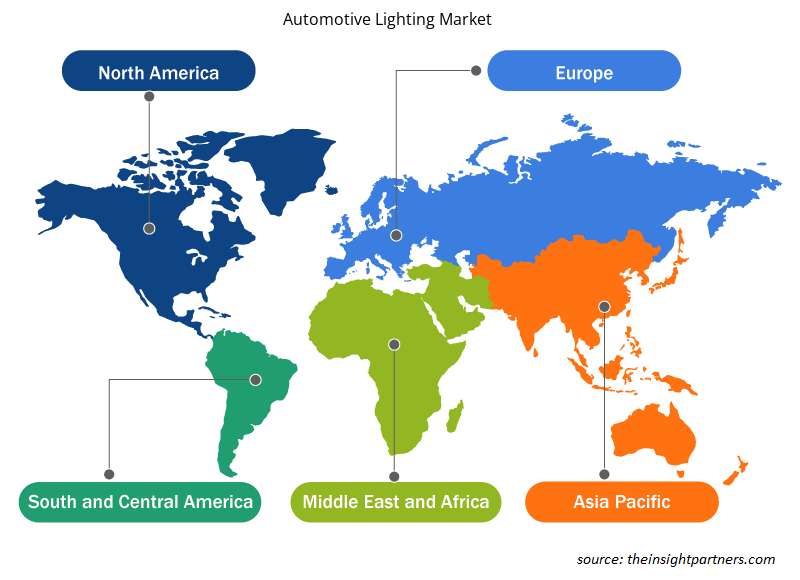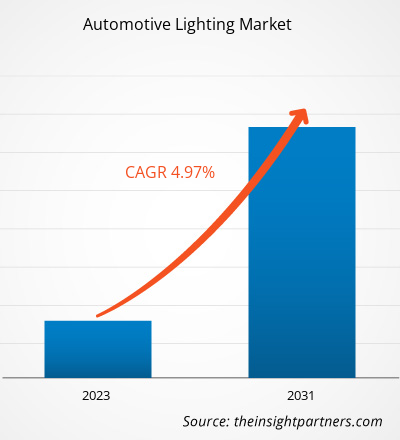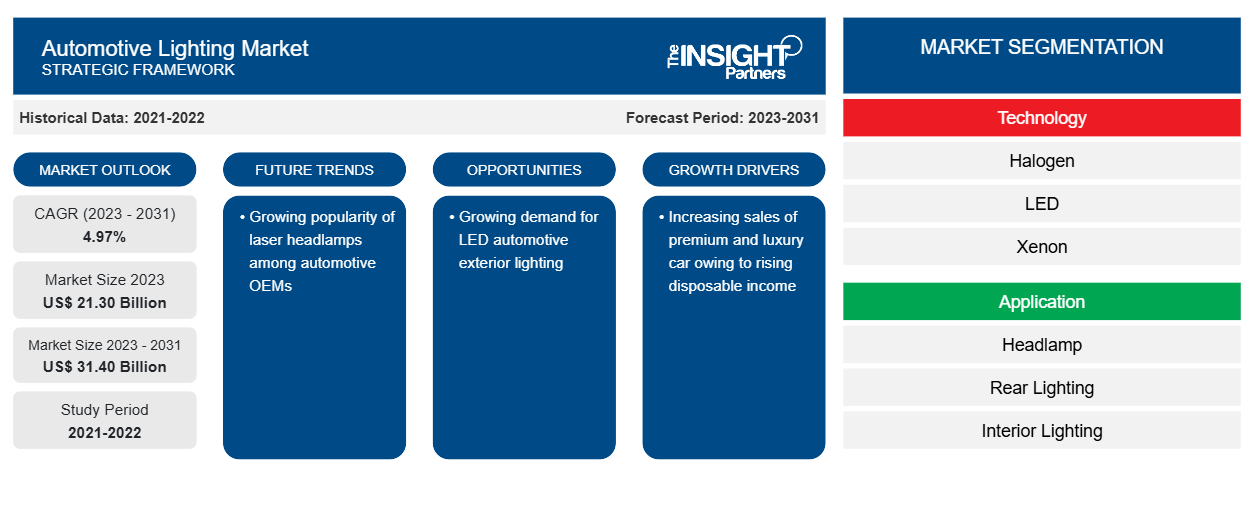Se prevé que el tamaño del mercado de iluminación automotriz alcance los 31.400 millones de dólares estadounidenses en 2031, frente a los 21.300 millones de dólares estadounidenses en 2023. Se espera que el mercado registre una CAGR del 4,97 % entre 2023 y 2031. El aumento de las ventas de automóviles de lujo y de alta gama está impulsando el mercado de iluminación automotriz y también brinda perspectivas de crecimiento a los proveedores de iluminación.
Análisis del mercado de iluminación automotriz
El ecosistema de iluminación automotriz consta de las siguientes partes interesadas principales, a saber: proveedores de materias primas, fabricantes/OEM de iluminación automotriz y usuarios finales. Los proveedores de materias primas incluyen proveedores que proporcionan componentes de materias primas clave para la iluminación automotriz, como cobre , aluminio, LED y diodos láser, entre otros. Los fabricantes/OES de iluminación automotriz, como Osram-Continental, Lumileds, Hella, Valeo y Automotive-Lighting, entre otros, integran y desarrollan iluminación automotriz para varios tipos de vehículos. Los OEM automotrices comparten los faros, las luces traseras y las luces de señalización o los planos específicos del vehículo con los proveedores. Los proveedores presentan cotizaciones únicas para ofertar por el acuerdo del proveedor. El proveedor que fue seleccionado luego proporciona los sistemas de iluminación específicos del vehículo durante la vigencia del acuerdo de licitación. Los OEM integran estos componentes de iluminación en su vehículo final.
Descripción general del mercado de iluminación automotriz
En la actualidad, las soluciones de iluminación matricial LED dominan las implementaciones totales de iluminación automotriz. Se espera que la tecnología de láser matricial mejore aún más la iluminación de la carretera gracias a sus características de alta resolución. La tecnología de láser matricial se basa en el LaserSpot para lámparas de luz de carretera. Con la tecnología de láser matricial, se ha hecho posible converger la tecnología de proyector en los faros de los automóviles de pasajeros. El factor de luminancia de los láseres es aproximadamente cinco veces mayor que otras fuentes de luz disponibles en el mercado y, por lo tanto, los faros láser proporcionan mayores alcances de haz a los conductores del vehículo. El alcance del haz de un faro láser típico supera los 500 m. El BMW i8 y el BMW 7 son las otras series de automóviles de pasajeros que cuentan con faros integrados con láser.
Personalice este informe según sus necesidades
Obtendrá personalización en cualquier informe, sin cargo, incluidas partes de este informe o análisis a nivel de país, paquete de datos de Excel, así como también grandes ofertas y descuentos para empresas emergentes y universidades.
-
Obtenga las principales tendencias clave del mercado de este informe.Esta muestra GRATUITA incluirá análisis de datos, desde tendencias del mercado hasta estimaciones y pronósticos.
Factores impulsores y oportunidades del mercado de iluminación automotriz
Aumento de las ventas de automóviles de lujo y de gama alta debido al aumento de la renta disponible
En los países desarrollados, donde los consumidores disponen de grandes ingresos, se ha observado que, con el aumento de la población vehicular, las preferencias de los consumidores a la hora de comprar coches de pasajeros difieren. Como resultado, el coste y la eficiencia del combustible ya no son los criterios principales para la compra de estos coches; en su lugar, las compras dependen más de la comodidad y el lujo que ofrecen. Además, los consumidores evalúan cada vez más los sistemas de iluminación y la ergonomía del coche a la hora de hacer sus selecciones.
Creciente demanda de iluminación LED exterior para automóviles
Según los datos de la Administración Nacional de Seguridad del Tráfico en las Carreteras (NHTSA), a pesar de que solo el 25% del tiempo total de conducción de los vehículos de pasajeros es de noche, aproximadamente el 50% de todas las muertes en vehículos de pasajeros se producen en la oscuridad. Esto se debe principalmente a la visibilidad inadecuada y la iluminación inadecuada en las carreteras, y a la iluminación insuficiente proporcionada por los faros de los vehículos. Las preocupaciones por la seguridad han impulsado a los fabricantes de automóviles a buscar una alternativa más segura. Los faros antiniebla LEDriving de OSRAM son notables en términos de innovación, diseño y rendimiento. Además, Philips ofrece tecnologías AirFlux y AirCool, que ayudan a controlar el calor producido por los faros antiniebla LED. Se trata de sistemas de refrigeración inteligentes que evitan que el calor llegue al componente crítico de la luz, lo que aumenta la resistencia al calor y prolonga de forma eficaz la vida útil de los LED.
Análisis de segmentación del informe de mercado de iluminación automotriz
Los segmentos clave que contribuyeron a la derivación del análisis del mercado de iluminación automotriz son la tecnología, la aplicación y el tipo de vehículo.
- Según la tecnología, el mercado de iluminación automotriz se ha dividido en halógeno, LED, xenón y láser. El segmento LED tuvo una mayor participación de mercado en 2023.
- Según la aplicación, el mercado de iluminación automotriz se segmenta en faros delanteros, iluminación trasera, iluminación interior, CHMSL, faros antiniebla y lámparas pequeñas. El segmento de faros delanteros tuvo la mayor participación del mercado en 2023.
- Según el tipo de vehículo, el mercado de iluminación automotriz se ha dividido en turismos, vehículos comerciales ligeros y vehículos comerciales ligeros y vehículos industriales pesados. El segmento de turismos tuvo una mayor participación de mercado en 2023.
Análisis del mercado de iluminación automotriz por geografía
El alcance geográfico del informe del mercado de iluminación automotriz se divide principalmente en cinco regiones: América del Norte, Europa, Asia Pacífico, Medio Oriente y África, y América del Sur.
El alcance del informe del mercado de iluminación automotriz abarca América del Norte (EE. UU., Canadá y México), Europa (España, Reino Unido, Alemania, Francia, Italia y el resto de Europa), Asia Pacífico (Corea del Sur, China, India, Japón, Australia y el resto de Asia Pacífico), Oriente Medio y África (Sudáfrica, Arabia Saudita, Emiratos Árabes Unidos y el resto de Oriente Medio y África) y América del Sur y Central (Brasil, Argentina y el resto de América del Sur y Central). En términos de ingresos, APAC dominó la participación de mercado de iluminación automotriz en 2023. Europa es el segundo mayor contribuyente al mercado mundial de iluminación automotriz, seguido de América del Norte.
Perspectivas regionales del mercado de iluminación automotriz
Los analistas de Insight Partners explicaron en detalle las tendencias y los factores regionales que influyen en el mercado de iluminación automotriz durante el período de pronóstico. Esta sección también analiza los segmentos y la geografía del mercado de iluminación automotriz en América del Norte, Europa, Asia Pacífico, Medio Oriente y África, y América del Sur y Central.

- Obtenga datos regionales específicos para el mercado de iluminación automotriz
Alcance del informe de mercado de iluminación automotriz
| Atributo del informe | Detalles |
|---|---|
| Tamaño del mercado en 2023 | US$ 21.30 mil millones |
| Tamaño del mercado en 2031 | US$ 31,40 mil millones |
| CAGR global (2023 - 2031) | 4,97% |
| Datos históricos | 2021-2022 |
| Período de pronóstico | 2023-2031 |
| Segmentos cubiertos |
Por tecnología
|
| Regiones y países cubiertos |
América del norte
|
| Líderes del mercado y perfiles de empresas clave |
|
Densidad de actores del mercado de iluminación automotriz: comprensión de su impacto en la dinámica empresarial
El mercado de iluminación automotriz está creciendo rápidamente, impulsado por la creciente demanda de los usuarios finales debido a factores como la evolución de las preferencias de los consumidores, los avances tecnológicos y una mayor conciencia de los beneficios del producto. A medida que aumenta la demanda, las empresas amplían sus ofertas, innovan para satisfacer las necesidades de los consumidores y aprovechan las tendencias emergentes, lo que impulsa aún más el crecimiento del mercado.
La densidad de actores del mercado se refiere a la distribución de las empresas o firmas que operan dentro de un mercado o industria en particular. Indica cuántos competidores (actores del mercado) están presentes en un espacio de mercado determinado en relación con su tamaño o valor total de mercado.
Las principales empresas que operan en el mercado de iluminación automotriz son:
- Iluminación automotriz LLC
- Hella GmbH & Co. KGaA
- Compañía de fabricación Koito
- Limitado.
- Lumileds Holding BV
Descargo de responsabilidad : Las empresas enumeradas anteriormente no están clasificadas en ningún orden particular.

- Obtenga una descripción general de los principales actores clave del mercado de iluminación automotriz
Noticias y desarrollos recientes del mercado de iluminación automotriz
El mercado de iluminación automotriz se evalúa mediante la recopilación de datos cualitativos y cuantitativos a partir de una investigación primaria y secundaria, que incluye publicaciones corporativas importantes, datos de asociaciones y bases de datos. A continuación, se incluye una lista de los avances en el mercado de iluminación automotriz y las estrategias:
- En julio de 2023, Marelli, junto con ams OSRAM, lanza una innovación revolucionaria en iluminación frontal para automóviles: el módulo h-Digi® microLED, que ya se encuentra en producción en serie. Esta solución de iluminación digital, basada en un nuevo tipo de LED multipíxel inteligente, permite un funcionamiento de los faros y una proyección de imágenes totalmente adaptativos y dinámicos, además de ser una tecnología asequible y disponible para una gama más amplia de vehículos. (Fuente: Marelli, Nota de prensa/Sitio web de la empresa/Boletín informativo)
- En diciembre de 2023, OLEDWorks anunció que exhibirá la última tecnología de iluminación OLED para la industria automotriz y redefinirá el panorama con el lanzamiento de una nueva y emocionante marca en CES 2024. El equipo de OLEDWorks, compuesto por expertos técnicos en OLED y estrategas de soluciones para clientes, espera con entusiasmo recibir a los asistentes en el stand n.° 3225 en el West Hall del Centro de Convenciones de Las Vegas, donde podrán experimentar las innovaciones de vanguardia que darán forma al futuro de la iluminación automotriz. (Fuente: OLEDWorks, comunicado de prensa/sitio web de la empresa/boletín informativo)
Informe de mercado de iluminación automotriz: cobertura y resultados
El informe “Tamaño y pronóstico del mercado de iluminación automotriz (2021-2031)” proporciona un análisis detallado del mercado que cubre las siguientes áreas:
- Tamaño del mercado y pronóstico a nivel global, regional y nacional para todos los segmentos clave del mercado cubiertos bajo el alcance
- Dinámica del mercado, como impulsores, restricciones y oportunidades clave
- Principales tendencias futuras
- Análisis detallado de las cinco fuerzas de Porter
- Análisis del mercado global y regional que cubre las tendencias clave del mercado, los principales actores, las regulaciones y los desarrollos recientes del mercado.
- Análisis del panorama de la industria y de la competencia que abarca la concentración del mercado, el análisis de mapas de calor, los actores destacados y los desarrollos recientes
- Perfiles de empresas detallados con análisis FODA
- Análisis histórico (2 años), año base, pronóstico (7 años) con CAGR
- Análisis PEST y FODA
- Tamaño del mercado, valor/volumen: global, regional y nacional
- Industria y panorama competitivo
- Conjunto de datos de Excel
Informes recientes
Testimonios
Razón para comprar
- Toma de decisiones informada
- Comprensión de la dinámica del mercado
- Análisis competitivo
- Información sobre clientes
- Pronósticos del mercado
- Mitigación de riesgos
- Planificación estratégica
- Justificación de la inversión
- Identificación de mercados emergentes
- Mejora de las estrategias de marketing
- Impulso de la eficiencia operativa
- Alineación con las tendencias regulatorias























 Obtenga una muestra gratuita para - Mercado de iluminación automotriz
Obtenga una muestra gratuita para - Mercado de iluminación automotriz